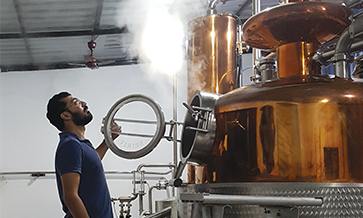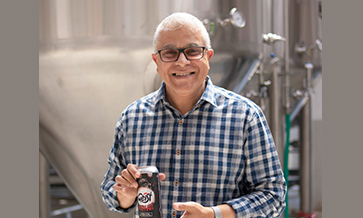Stone Brewing Co. was founded in 1996 by Steve Wagner, along with his partner Greg Koch. Steve was the original brewmaster of the company and developed several of Stone’s award-winning recipes, including its IPA,Pale Ale, Smoked Porter, Imperial Russian Stout, and the iconic Arrogant Bastard Ale.
In a free-wheeling interview with Roy Thomas, Steve spoke about how, against several odds, they managed to pull off what is, arguably, one of the biggest success stories in the history of craft beer in the US.
Tell us about your craft beer journey?
In the early 1990s, I was a professional musician and played in a rock band that rehearsed at a studio my partner Koch owned. Much later, at a chance meeting at the University of California-Davis’ extension course about beer, we got talking and spoke about our mutual fondness for craft-brewed beer.
I subsequently took a job at Pyramid Breweries in Washington State in 1994 to learn brewing. Koch and I kept in touch and eventually decided to open a brewery.
California’s bustling beer scene had gone national by the early 1990s and the sky seemed the limit – and we decided to take the plunge. The going was initially very tough, but it was sheer persistence and lots of hard work that pulled us through. The rest, as they say, is history. Honestly, I pinch myself sometimes to check if all of this is really happening!
What were some of the early setbacks and challenges that you faced?
Although we were confident of our product, we had to organise the distribution and persuade outlets to keep our beers on tap in their restaurants. Financially it was also tough as we were literally hand-selling our products. Besides, we had to arrange for distributors to get the beers across to the outlets in the best condition.
Our strategy of supplying our beer for community events and to ‘Not for profit’ organisations paid off and people got to taste and love our beers. Subsequently, it was word of mouth as folks told their friends about how good it was. That, in a way, is our strategy till today.
Distribution was another ball game: we self-distributed for some time and started looking for someone who would do this work. This also didn’t work out, so we eventually decided to do it ourselves and started a business unit that did this work, not only for us but for other breweries also.
Today, we are a legitimate distributor having a fleet over 100 refrigerated trucks distributing 40 other craft beer brands across southern California.
Which beer style did you brew first as a home brewer?
The brewery’s inaugural offering was a Pale Ale, the first keg of which the Pizza Port Brewing Co. bought in July 1996 for its restaurant in Solana Beach. Arrogant Bastard, though, was still nearly two years off as a commercial release when Stone opened in San Marcos in February 1996.
What do you consider the three most important success ingredients of Stone Brewing Co.?
Stone’s strong, bitter, full-bodied flavours were all made with a passion to be the best in the market. Our belief in our products was important, and we were sure that once the consumer tried these beers they would love it.
We place importance on the freshness of our products and on supplying what the market wants. We continue to push the envelope regarding quality and this means ensuring that the best machinery and ingredients are used in the production.
Currently, our craft beers are supplied in all 50 states of the US and also to Europe. In addition, we have our restaurant and tap room in Shangai (China) that is doing well. We will also be opening one shortly in Beijing too!
What’s your advice to a microbrewery and a new beer brand?
My advice is to be willing to take risks and never be satisfied. There’s always something you can do better. My partner Koch also offers sound advice to entrepreneurs when he says, “Be true to yourself. Ignore everybody. Do it the way you think it should be done.”
Finally, a word of caution: Don’t over-extend yourself to the point where you find yourself running out of capital on the home stretch. Financial prudence is something that all businesses have to keep in mind.
For a sustainable brewing business, what matters the most?
I think one of the most important ingredients is a passion for brewing. If the passion for it is there, then the rest falls in place. But if one looks as it purely as commercial venture, chances of slipping up and giving up are possible.
What would be your advice to a brand making a move from keg/taproom to bottled beer?
As a company looks to grow from a keg/taproom, bottled and canned beer would seem like a natural progression. However, one needs to just understand the scope of what you are taking on, to make sure that you don’t over-extend yourself.
As your expansion is nearing completion you find out you are running out of funds or human resources – that could be a real danger for small companies as they look to transition. Without proper planning and adequate resources, it could rock the financial viability of the entire company.
What would you like to say to a home brewer who wishes to turn pro?
Always keep detailed records of your brewing, so that if you come up with that fantastic beer, you can repeat it. Taste as many commercial craft beers as you can to compare to your beers and to develop your palate.
When possible, enter your beer into local and national contests and competitions to get feedback from experienced beer judges. If you want to start your own brewery, remember that great beer is not enough! You need to build a solid brand with unique marketing – and it all needs to be supported by sound business practices.
How did you get involved with Geist?
Narayan (Manepally) worked with my brother at Intel in Portland (Oregon) for several years. When Narayan mentioned to Dan that he was interested in starting a brewery, Dan referred him to me, since I was already involved in brewing.
Narayan came and toured our facility in San Diego in 1998 and our new brewery in San Diego in 2006. When Geist decided to build a production brewery, I provided some free technical advice and became quite enthused about the project and the opportunity for craft beer in India. So I decided to become an investor as well!
By the way, we have brewed a new craft beer recently at Geist using cucumber and salt. That should be ready in two weeks and so I should be back in Bengaluru for the launch!
Where do you see the Indian craft beer industry in the next 5 years?
In many ways, India was what the US was 30 years ago. Currently, India’s craft beer industry accounts for 2-3% of the country’s production, while in the US it now accounts for around 15% of the market. That will probably give you an idea of the scope for growth.
There is a burgeoning aspirational middle-class with high disposable incomes that has travelled widely. Many of them are particularly interested in this form of beer that is more authentic, premium and has a complex flavour compared to regular lager.
Having tasted the ‘good life’ they are willing to try and out new brands, including brews and spirits. A word of caution – Millennials are impatient and are constantly looking for new things to try out; so it is important to always keep new recipes and launches ready in the pipeline.
What are your expectations from the Indian beer market?
The concept of small-batch, hand-brewed craft beers and India Pale Ales has enthused the Indian beer-drinking community. Several brewpubs and micro-breweries have come up in the recent past. I understand that from just two about 10 years ago there are around 170 outlets in the country and counting.
There will eventually be a shake-up – if that is not happening already – where the men will be separated from the boys. The ones that will succeed would be the ones who are passionate about their product and have a pulse of the market.
IMAGE AND CAPTIONS:
IMAGE:Passing-Wagner1: Since its inception in 1996, Stone Brewing Co. has developed several award-winning recipes, and is the biggest success story in the history of craft beer in the US.
IMAGE:Passing-Wagner2-A, Passing-Wagner2-B : Steve with Geist’s Narayan Manepally at the Hoskote brewery (L), where the former recently brewed a new beer using cucumber and salt.













